Athletes in Canada are changing how they recover with new home tools. Riverside Sports Therapy shows how these tools are key for better performance and healing. Now, athletes use advanced home solutions instead of just old methods.
The way athletes recover has changed a lot. Today’s home recovery gadgets are very advanced. They help athletes heal faster, feel less sore, and perform better without needing a doctor all the time.
Both pros and amateurs know recovery is as important as training. Using special home tools, athletes can heal better, adapt faster, and perform at their best.
Key Takeaways
- Home recovery tools provide professional-grade healing techniques
- Technology enables personalized athletic recovery strategies
- Modern recovery methods reduce injury risks
- Accessible tools support faster muscle rehabilitation
- Cost-effective alternative to frequent professional therapy sessions
Understanding the Importance of Athletic Recovery Equipment
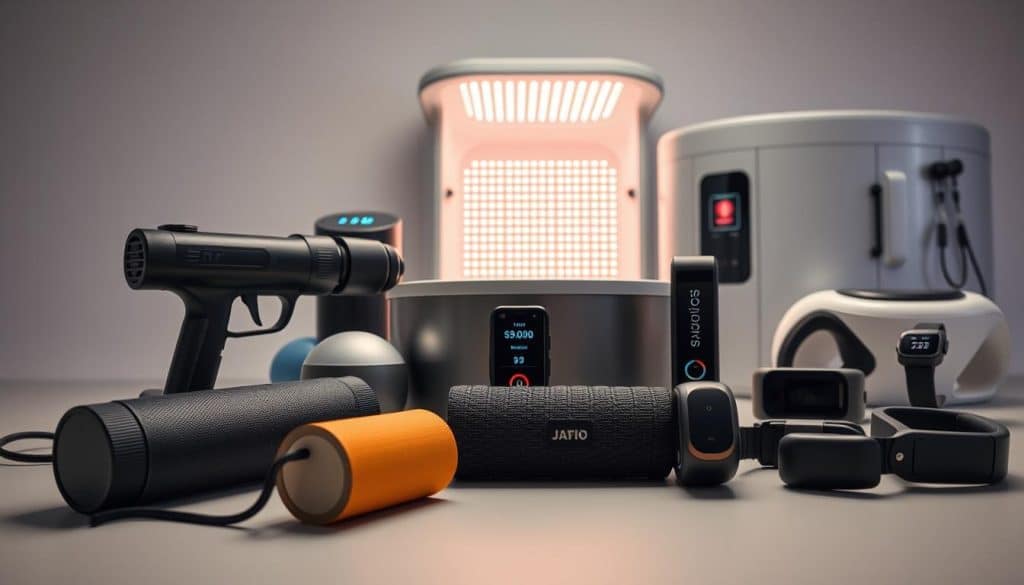
Athletic performance is more than just intense training. Professional athletes know recovery is key to staying fit. New technology has changed how athletes heal after workouts.
The body needs smart recovery to stay at top shape and avoid injuries. Recovery tools are vital for athletes. They help reduce muscle soreness, lower inflammation, and speed up healing.
The Science Behind Post-Workout Recovery
Science shows muscles fix themselves when we rest, not when we exercise. Important recovery steps include:
- Reducing muscle inflammation
- Restoring cellular energy reserves
- Repairing tiny muscle tissue damage
- Removing waste from muscles
“Recovery is where the real athletic transformation happens.” – Dr. Michael Breus, Performance Recovery Specialist
Why Professional Athletes Prioritize Recovery Tools
Top athletes spend a lot on the latest recovery tech. These tools help them:
- Shorten time off between workouts
- Fix muscles faster
- Stay injury-free
- Keep their performance high
Impact on Performance and Injury Prevention
Advanced recovery tech lets athletes train better and more often. It supports the body’s healing, keeping athletes in top shape and lowering injury risk.
Today’s recovery methods are as critical as the workout itself for athletes.
Top Gadgets for Athlete Recovery at Home
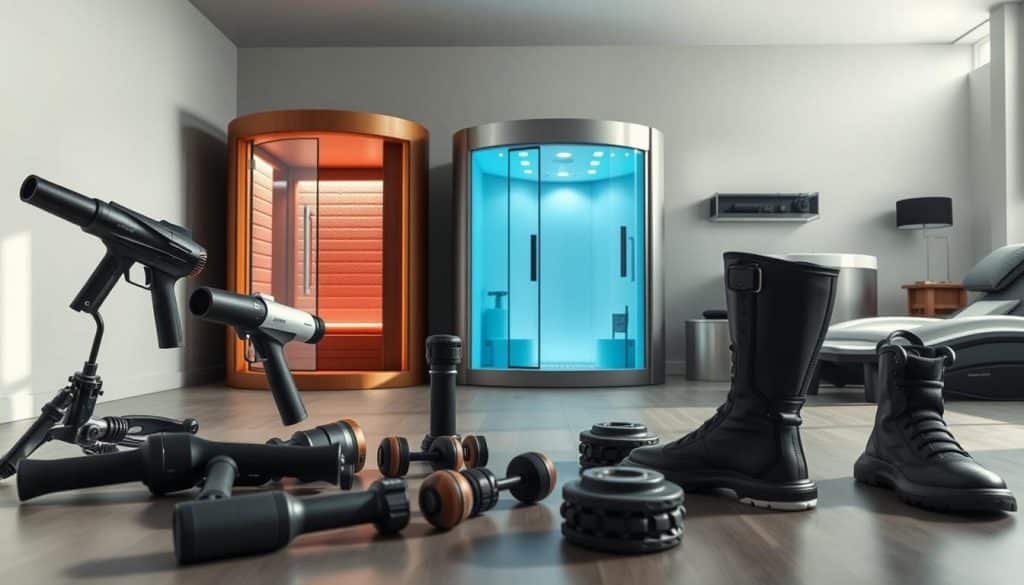
Athletes are now using advanced gadgets to improve their recovery at home. These tools help them heal faster and stay in top shape. They’ve changed how athletes recover after workouts.
Today’s recovery tech gives athletes powerful tools to heal faster and feel less sore. These gadgets offer solutions that were once only found in pro training centers. They help athletes recover better and perform better too.
- Percussion massage devices
- Compression recovery systems
- Electronic muscle stimulation (EMS) tools
- Smart wearable recovery technology
- Advanced foam rollers
Each gadget has its own role in helping athletes recover. They help athletes:
- Reduce muscle inflammation
- Improve blood circulation
- Accelerate tissue repair
- Minimize recovery time
- Prevent injuries
| Recovery Gadget Type | Primary Function | Average Price Range |
|---|---|---|
| Massage Guns | Deep tissue muscle treatment | $150 – $500 |
| Compression Sleeves | Improve blood flow | $50 – $250 |
| EMS Devices | Muscle stimulation | $100 – $300 |
Investing in quality muscle recovery gadgets can significantly enhance an athlete’s home recovery experience and long-term performance.
Massage Guns: The Ultimate Deep Tissue Solution
Athletes are always looking for new ways to recover after workouts. Massage guns have become a key tool for muscle care and better performance.
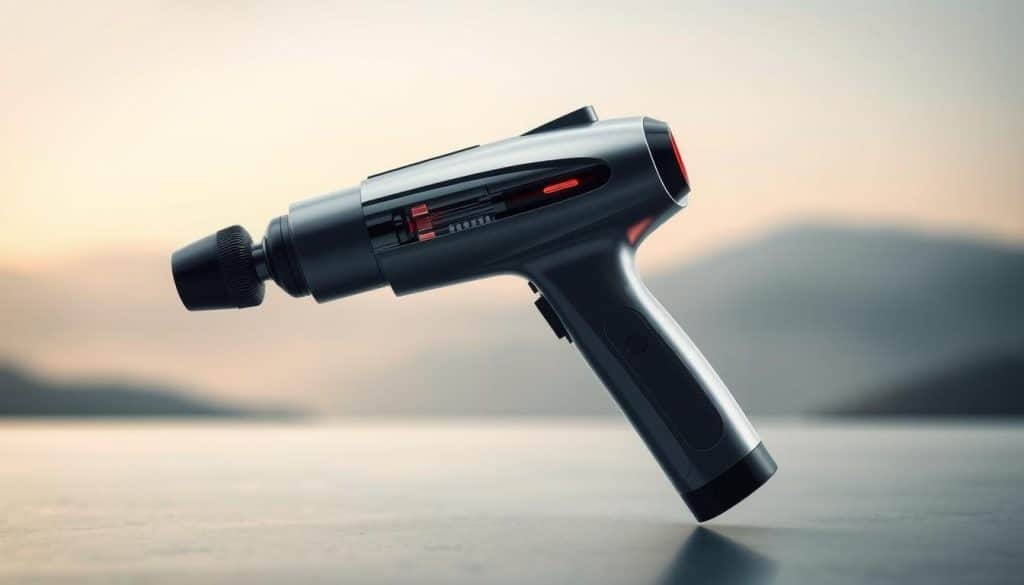
These handheld devices are a big step forward in recovery tech. They give deep massages to muscles, helping athletes feel less sore and recover faster.
Essential Features to Consider
When picking a massage gun, athletes should look at a few important things:
- Battery life duration
- Adjustable speed settings
- Noise level
- Interchangeable attachment heads
- Weight and portability
Best Practices for Effective Usage
Using a massage gun right is key to getting the most out of it. Experts suggest:
- Start with lower intensity settings
- Limit sessions to 10-15 minutes
- Move consistently across muscle groups
- Avoid direct contact with bones or joints
Top Recommended Brands
Top athletes often choose brands like Theragun, Hyperice, and TimTam. They’re known for their quality and design in recovery tools.
“Massage guns have revolutionized how athletes approach muscle recovery and performance enhancement.” – Sports Medicine Research Institute
Getting a good massage gun can really help with recovery. It can lower muscle tension and help prevent injuries.
Compression Recovery Systems: Benefits and Options

Athletes are now using compression recovery systems to get better. These smart tools help support muscles and speed up recovery after workouts.
Compression technology applies gentle pressure to muscles. This improves blood flow and lessens muscle tiredness. You can find everything from simple sleeves to advanced pneumatic devices for recovery.
- Graduated compression garments for lower body recovery
- Pneumatic compression devices with customizable settings
- Portable compression systems for on-the-go athletes
Professional athletes love these tools for many reasons. They help:
- Reduce muscle soreness after intense training
- Speed up muscle repair and growth
- Lessen inflammation and swelling
- Boost muscle performance
Modern compression recovery systems are a big step forward in sports science. They let athletes fine-tune their recovery with the latest tech.
“Compression technology is changing how athletes recover and improve their performance.” – Sports Performance Institute
Smart Recovery Wearables and Technology
Athletes are now using wearable recovery tech to change the game. It helps them understand and improve their body’s performance and healing. This smart equipment lets athletes track and manage their physical state like never before.
Modern wearables give athletes a detailed look at their body’s responses. They turn old recovery methods into new, data-driven ones. These devices collect health metrics that show how well an athlete is recovering.
Activity Tracking for Recovery Optimization
Today’s smart recovery gear lets athletes watch key recovery signs:
- Heart rate variability
- Sleep quality
- Muscle strain levels
- Metabolic recovery rates
Integration with Training Apps
Wearable recovery tech works with top training apps. Athletes can see how they’re doing and recovering in real-time. These apps give tips on rest, food, and how hard to train.
| Device Type | Recovery Metrics Tracked | App Integration |
|---|---|---|
| Smartwatches | Heart Rate, Sleep, Stress | Strava, TrainingPeaks |
| Fitness Bands | Movement, Calories, Recovery | Apple Health, Garmin Connect |
| Recovery Sensors | Muscle Strain, Fatigue | Whoop, Oura Ring |
Real-time Recovery Monitoring
The newest wearable recovery tech gives athletes quick feedback on their body. It looks at physical data to stop overtraining and lower injury risks.
Foam Rollers and Myofascial Release Tools
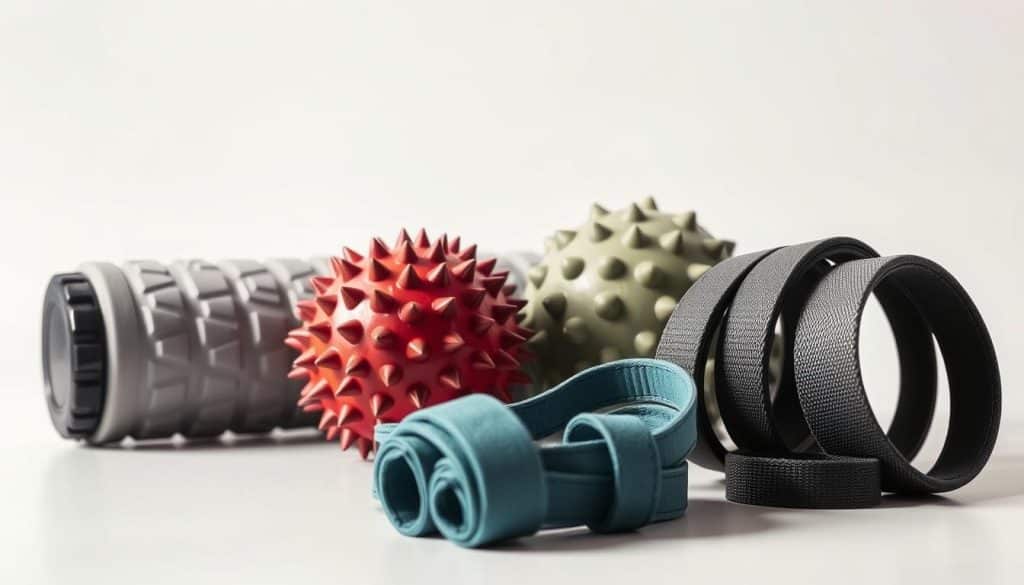
Muscle recovery gadgets have changed how athletes and fitness fans recover after workouts. Foam rollers are a top choice for easing muscle tension and boosting flexibility at home.
Myofascial release focuses on the tissue around muscles. Foam rollers offer a budget-friendly way to do self-massage. They help break down muscle knots and cut down recovery time.
“Consistent use of foam rollers can significantly improve muscle performance and reduce injury risk.” – Sports Rehabilitation Experts
- Reduces muscle soreness after intense workouts
- Increases blood circulation
- Improves overall muscle flexibility
- Helps prevent possible injuries
When picking home recovery tools like foam rollers, think about these important points:
- Density of the roller
- Surface texture
- Size and portability
- Material quality
Athletes can pick from different foam roller types. There are smooth rollers for newbies and textured rollers for deeper muscle work. Adding these muscle recovery gadgets to your routine can change your recovery process.
Recovery Ice Bath and Cold Therapy Solutions
Athletes are now using cold therapy to help their bodies recover after workouts. This method is key in modern recovery tools, helping muscles heal fast and reducing swelling.

Cold therapy tightens blood vessels and slows down body processes. This helps prevent muscle damage and swelling after hard workouts. Many athletes and trainers swear by its benefits.
Portable Cold Therapy Options
Today’s cold therapy options are more than just ice baths. Athletes can now use portable devices that make recovery easy and quick:
- Compact cold therapy wraps
- Portable ice bath containers
- Wearable cooling systems
- Cryotherapy-inspired recovery devices
Temperature Control and Safety Guidelines
It’s important to control the temperature when using cold therapy. Here are some key safety tips:
| Recovery Method | Recommended Temperature | Duration |
|---|---|---|
| Ice Bath | 50-59°F (10-15°C) | 10-15 minutes |
| Cold Compress | 32-40°F (0-4°C) | 15-20 minutes |
| Localized Cooling | 45-55°F (7-13°C) | 5-10 minutes |
“Cold therapy is not just about temperature, but strategic recovery,” says Dr. Sarah Reynolds, sports medicine specialist.
Warning: Always talk to a doctor before starting any new recovery plan, if you have health issues.
Electronic Muscle Stimulation (EMS) Devices
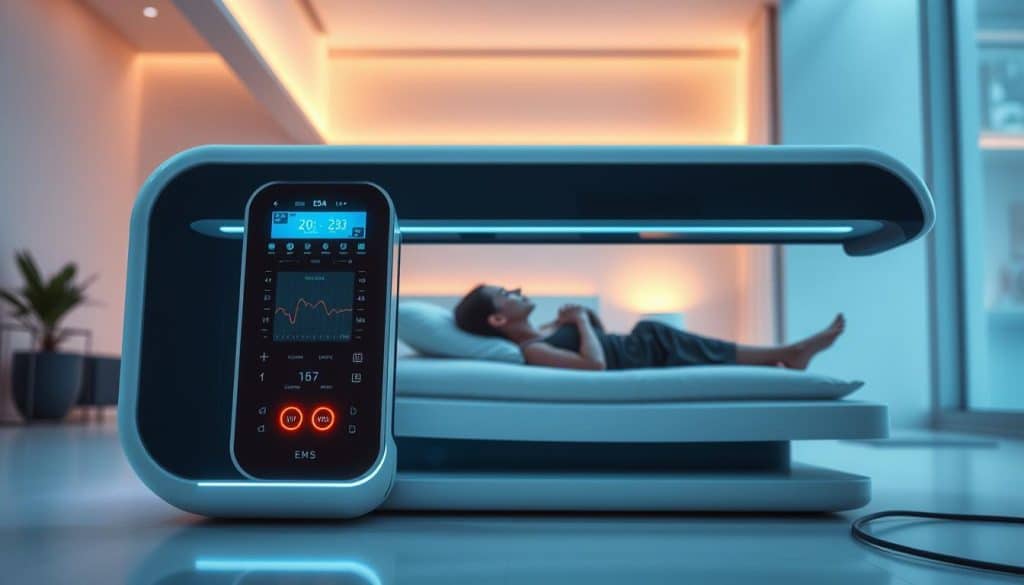
Fitness recovery technology has changed how athletes recover. Electronic Muscle Stimulation (EMS) devices are at the forefront. They send electrical impulses to muscles, speeding up recovery and boosting performance.
EMS devices send electrical currents through pads on muscles. This stimulates the muscles, improving blood flow and reducing soreness. It helps muscles recover faster.
- Accelerates muscle recovery time
- Reduces post-workout muscle soreness
- Improves muscle strength and endurance
- Supports injury rehabilitation
Professional athletes and fitness lovers use EMS technology. It helps them train better and recover faster. These devices have different levels and modes to focus on specific muscles.
| EMS Device Type | Primary Benefits | Recommended Use |
|---|---|---|
| Wireless Portable EMS | Convenient, Mobile Recovery | Post-workout muscle relaxation |
| Professional-Grade EMS | Intense Muscle Stimulation | Targeted rehabilitation |
| Wearable EMS Units | Continuous Muscle Conditioning | Active recovery and training |
Safety is key when using EMS devices. Always follow the maker’s instructions. Start with low intensity and talk to a doctor for advice.
Heat Therapy and Infrared Recovery Tools
Athletes are now using advanced heat therapy and infrared technologies for recovery at home. These tools help relax muscles and speed up healing. This can greatly reduce recovery time and improve performance.
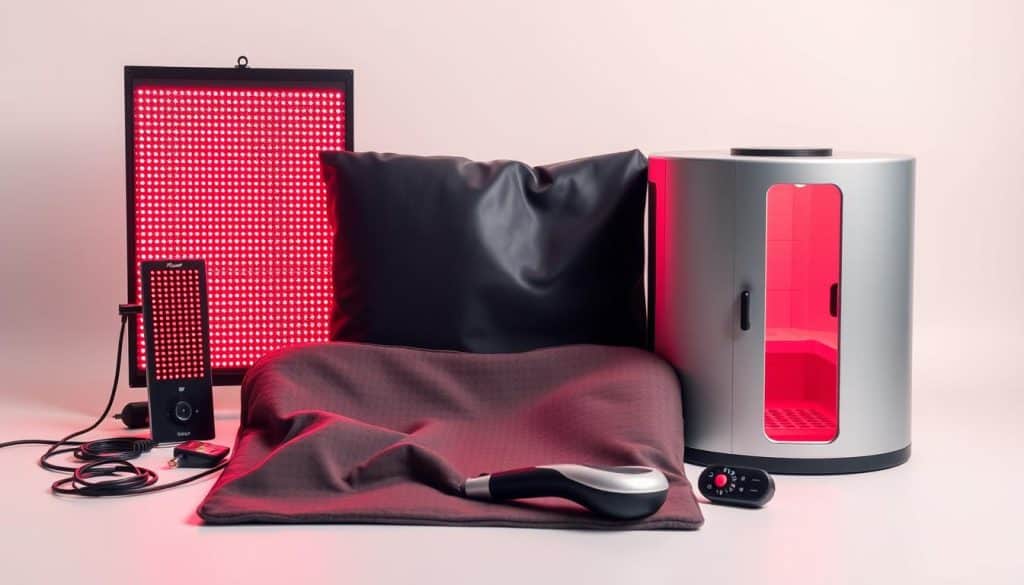
Heat therapy is a big change in how athletes recover. It uses warmth to relax muscles, improve blood flow, and heal faster.
Portable Heat Therapy Options
Today, athletes have many portable heat therapy options for recovery:
- Heated compression wraps
- Portable infrared heating pads
- Wearable heat therapy devices
- Electric muscle warming units
Benefits of Infrared Technology
Infrared tools offer special benefits for athletes looking for advanced healing:
| Infrared Benefit | Athletic Impact |
|---|---|
| Deep Tissue Penetration | Accelerates muscle recovery |
| Improved Circulation | Reduces inflammation |
| Cellular Regeneration | Speeds healing process |
“Infrared technology transforms how athletes approach recovery, providing precise healing at the cellular level.” – Sports Recovery Research Institute
Professional athletes see how smart recovery equipment like infrared tools can greatly improve performance and prevent injuries.
Recovery Footwear and Compression Gear
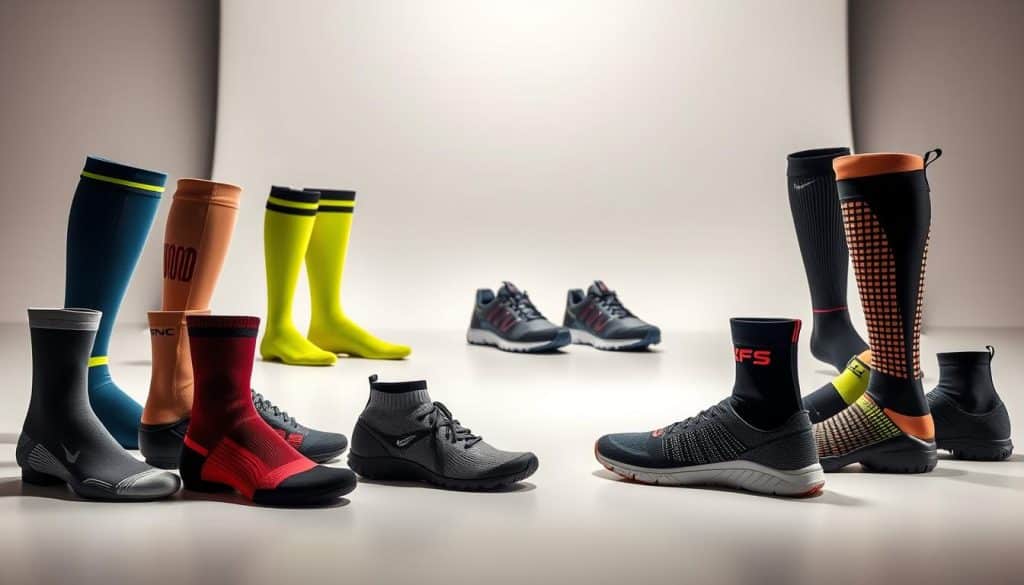
Athletes know how important good recovery gear is. It helps them stay at their best. Recovery shoes and compression gear are key tools for muscle recovery and lessening physical strain after hard workouts.
Recovery shoes offer big benefits for athletes looking to fully recover. They have special designs that help with:
- Improved blood flow
- Less muscle tiredness
- Quicker recovery between workouts
- Less muscle soreness after working out
Compression gear is also vital for recovery. Graduated compression socks and sleeves apply the right pressure to muscles. This helps them heal faster and reduces swelling. Top athletes use these to get back to their best quickly.
When picking recovery shoes and compression gear, athletes should think about a few things:
- How well it breathes
- The level of compression
- If it’s designed for their sport
- How comfortable it is
Brands like OOFOS, 2XU, and Compex make advanced recovery gear. They use the latest tech to help athletes recover. Getting good recovery shoes and compression gear can really help an athlete’s performance and prevent injuries.
Flexibility and Mobility Enhancement Tools
Athletes know that flexibility is key for fitness recovery. Keeping your body mobile helps avoid injuries and boosts performance. The right gadgets can change your stretching and mobility routine, making recovery better and more focused.
Being flexible means you recover faster and perform better. Today’s fitness tech has changed how athletes work on mobility. It offers new tools that go beyond old stretching methods.
Dynamic Stretching Equipment
Dynamic stretching tools are now a must-have for athletes. These gadgets help athletes:
- Increase range of motion
- Reduce muscle tension
- Improve overall flexibility
- Prevent injuries
Mobility Band Selection Guide
Choosing the right mobility bands is important. Resistance levels, material quality, and intended use matter a lot in picking good fitness tech.
When picking mobility bands, think about:
- Your fitness level
- The resistance range
- The band’s durability
- The type of workout you do
Professional athletes and fitness fans know that good recovery gadgets are worth it. Adding these tools to your routine makes workouts better and safer.
Sleep and Recovery Tracking Devices
Athletes know that good sleep is key to recovery. Wearable tech has changed how athletes track and improve their sleep. Now, smart gear gives deep insights into rest and healing.
Today’s sleep trackers do more than just monitor sleep. They offer detailed data on sleep quality, length, and how well you recover.
- Track sleep stages and cycles
- Monitor heart rate variability
- Analyze breathing patterns
- Provide personalized recovery recommendations
Key sleep tracking technologies include:
| Device Type | Key Features | Recovery Impact |
|---|---|---|
| Smartwatches | 24/7 sleep monitoring | Comprehensive recovery insights |
| Headband Sensors | Brainwave tracking | Detailed sleep stage analysis |
| Smart Mattress Covers | Temperature regulation | Optimal sleep environment |
Athletes can now use these smart devices to improve their recovery plans. By knowing their sleep patterns, they can make better choices to boost performance and lower injury risks.
“Sleep is the most effective recovery tool in an athlete’s arsenal.” – Sports Performance Expert
Adding wearable recovery tech to training routines helps athletes get ahead. They can monitor sleep and recovery closely.
Hydration and Nutrition Monitoring Tools
Athletic recovery innovations have changed how athletes handle hydration and nutrition. Today, technology offers advanced tools for tracking and monitoring. These tools help athletes improve their recovery by providing detailed data.
Smart water bottles and hydration trackers are at the forefront of these innovations. They ensure athletes drink the right amount of water. These devices give real-time updates on an athlete’s hydration levels.
Smart Water Bottle Features
- Bluetooth connectivity for tracking water intake
- Personalized hydration recommendations
- Integrated LED reminder systems
- Compatibility with fitness tracking apps
Nutrition Timing Technology
Now, athletes can use advanced nutrition monitoring systems at home. These systems help athletes find the best times to eat. They analyze metabolic data to suggest meal times and what to eat.
| Technology | Key Function | Recovery Impact |
|---|---|---|
| Smart Nutrition Apps | Personalized meal planning | Accelerated muscle repair |
| Metabolic Trackers | Real-time nutrient absorption | Enhanced energy restoration |
| Macronutrient Analyzers | Precise nutrient ratio tracking | Optimized recovery strategies |
Investing in these technological solutions can significantly improve an athlete’s recovery process by providing data-driven insights into hydration and nutrition.
Creating Your Home Recovery Station
Creating a home recovery station needs careful planning and organization. Athletes need a special area for their recovery tools. This space should help them get back to their best performance.
First, pick a spot in your home that:
- Has enough room to move around
- Is well-lit and has good air flow
- Is close to power outlets
- Is away from distractions
Your recovery station should have all the necessary tools in easy-to-reach spots. Make sure everything is easy to get to and use regularly.
Organize your tools into categories:
- Tools for soft tissue (massage guns, foam rollers)
- Compression and circulation tools
- Equipment for temperature therapy
- Stuff for stretching and mobility
Use storage like wall racks, shelves, or small cabinets to keep things neat. A clean space makes it easier to stick to your recovery routine.
“An organized recovery station is the foundation of an athlete’s home wellness strategy.”
Your recovery station should fit your needs and goals. Use the best gadgets for your athletic level and recovery needs.
Investment Guide: Budget-Friendly to Premium Options
Choosing the right athlete recovery devices is all about smart money management. Fitness recovery technology has something for every budget. This makes it key to invest wisely for top performance and recovery.
Cost-Benefit Analysis of Recovery Tools
When looking at athlete recovery devices, keep these points in mind:
- Initial cost of the device
- Durability and long-term value
- Potential injury prevention benefits
- Compatibility with your specific training regimen
Where to Invest First
For athletes starting to build their recovery tech, focus on what you need most:
- Entry-Level Options: Foam rollers and basic massage tools ($30-$100)
- Mid-Range Investments: Percussion massage guns ($200-$400)
- Advanced Recovery: Compression systems and smart wearables ($500-$1000)
Smart athletes see recovery as an investment in their performance. Start with tools that are versatile and meet many recovery needs. They should also fit your budget.
Remember: The most expensive device isn’t always the best. Focus on quality and personal recovery requirements.
Conclusion
Using top gadgets for athlete recovery at home has changed how athletes recover after workouts. Now, athletes can use a wide range of tools to help their bodies heal. This lets them bring professional-level care right to their homes.
Knowing how important recovery technology is can really help an athlete’s performance. Tools like massage guns and compression systems offer specific support. They help athletes stay in top shape without needing constant help from professionals.
For athletes in Calgary looking for the best recovery strategies, Riverside Sports Therapy is a great resource. Located in Calgary, AB, their team helps athletes improve their recovery methods. Athletes can call Riverside Sports Therapy at (403) 283-7551 for advice on recovery solutions that fit their training needs.
As recovery technology gets better, athletes have more chances to improve their training and recover faster. Investing in good recovery tools is now key for athletes to succeed. It’s not just a luxury anymore, but a must for athletes to reach their goals.
FAQ
What are the most important recovery tools for athletes?
How often should I use recovery tools?
Are home recovery tools as effective as professional therapy?
How much should I invest in recovery tools?
What are the most important recovery tools for athletes?
How often should I use recovery tools?
Are home recovery tools as effective as professional therapy?
How much should I invest in recovery tools?
FAQ
What are the most important recovery tools for athletes?
Key recovery tools include massage guns, compression systems, and foam rollers. Cold therapy devices, EMS devices, and smart wearables are also vital. Each tool helps with muscle recovery, reduces inflammation, and prevents injuries.
How often should I use recovery tools?
Use recovery tools daily or after workouts, depending on your training. Massage guns are best used 2-3 times a week. Use compression systems for 15-30 minutes after hard workouts. Foam rolling is good daily for 10-15 minutes.
Are home recovery tools as effective as professional therapy?
Home recovery tools are getting better. They can offer professional-grade benefits when used right and often. Advanced tools like massage guns and smart wearables are key.
How much should I invest in recovery tools?
Recovery tool prices vary from to
FAQ
What are the most important recovery tools for athletes?
Key recovery tools include massage guns, compression systems, and foam rollers. Cold therapy devices, EMS devices, and smart wearables are also vital. Each tool helps with muscle recovery, reduces inflammation, and prevents injuries.
How often should I use recovery tools?
Use recovery tools daily or after workouts, depending on your training. Massage guns are best used 2-3 times a week. Use compression systems for 15-30 minutes after hard workouts. Foam rolling is good daily for 10-15 minutes.
Are home recovery tools as effective as professional therapy?
Home recovery tools are getting better. They can offer professional-grade benefits when used right and often. Advanced tools like massage guns and smart wearables are key.
How much should I invest in recovery tools?
Recovery tool prices vary from $50 to $1,000. Foam rollers start at $20-$50. High-end tools like massage guns cost $300-$800. Start with basics and add more as needed.
Can recovery tools help prevent sports injuries?
Yes, they help prevent injuries by improving flexibility and blood flow. They also reduce muscle tension and speed up recovery. Regular use can lower injury risk and boost performance.
Are electronic muscle stimulation (EMS) devices safe for home use?
EMS devices are safe if used as directed. But people with heart issues or epilepsy should talk to a doctor first. Always start with low intensity and follow guidelines.
How do I choose the right recovery tool for my specific sport?
Think about your sport’s demands and muscle stress. Runners might need foam rollers and compression. Weightlifters might prefer massage guns and EMS. Sports therapy experts can guide you.
Can recovery tools improve sleep and overall athletic performance?
Yes, they can. Recovery tools and sleep trackers help improve rest and reduce soreness. They support faster recovery. This leads to better performance, less fatigue, and consistent training.
,000. Foam rollers start at -. High-end tools like massage guns cost 0-0. Start with basics and add more as needed.
Can recovery tools help prevent sports injuries?
Yes, they help prevent injuries by improving flexibility and blood flow. They also reduce muscle tension and speed up recovery. Regular use can lower injury risk and boost performance.
Are electronic muscle stimulation (EMS) devices safe for home use?
EMS devices are safe if used as directed. But people with heart issues or epilepsy should talk to a doctor first. Always start with low intensity and follow guidelines.
How do I choose the right recovery tool for my specific sport?
Think about your sport’s demands and muscle stress. Runners might need foam rollers and compression. Weightlifters might prefer massage guns and EMS. Sports therapy experts can guide you.
Can recovery tools improve sleep and overall athletic performance?
Yes, they can. Recovery tools and sleep trackers help improve rest and reduce soreness. They support faster recovery. This leads to better performance, less fatigue, and consistent training.
